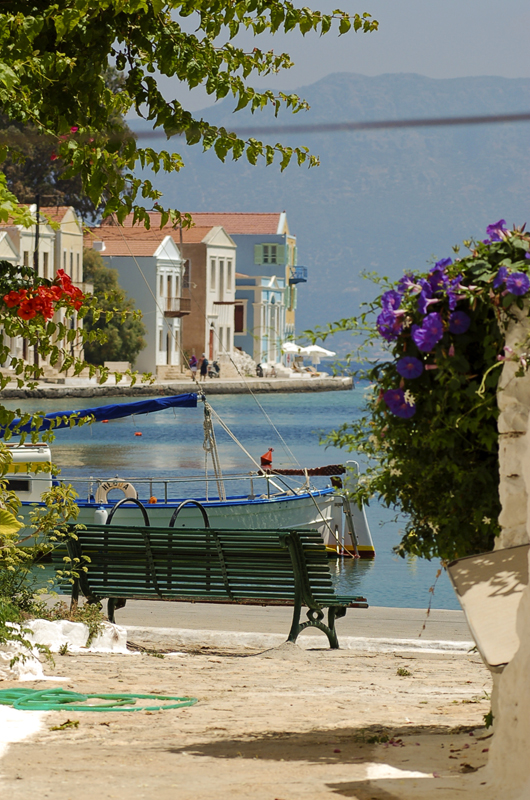The greek island kastellorizo (meis).....

THE GREEK ISLAND KASTELLORIZO
.

Kastellorizo is an island with a rich nautical tradition that explains the noble air about the island that reflects its part glory and prosperity. Kastellorizo is the harbour and only settlement of the island and it is said that it is the best natural port of the Mediterranean. All islands inhabitants are gathered here. The painted in vivid colors two and three story renovated mansions, spread along the harbourline offering an unrivalled amongst other islands beauty.
Location:
Not even 2 km opposite to Kas at the Lycian Coast, the small Greek Island Kastellorizo (turk. Meis) can be easily reached from the harbour of Kaş, where you will find several boats offering daily trips to the Island of Meis.
History:
The small but historic little island of Kastellorizo was called Megisti in ancient times after its first settler Megisteas. The island was inhabited since the Neolithic and meso-minoic times. Then the Dorians settled there, as they did on all the Dodecanese islands.
Τhe island had its own civilization, judging from the ancient findings, the inscriptions, tombs, walls and the remains of the temple of Apollo Megisteas whose worship was wide spread on the island as well as on the nearby coasts of Asia Minor.
Megisti took part in the Trojan War along with the other Dodecanese islands and being an ally of the Athenians helped them in their battles against the Persians. The island was conquered by the Romans, the Byzantines and then in 1306 by the Knights of St. John of Rhodes who built the castle with its tall twin walls and loopholes, making it one of the strongest fortresses of the Aegean Sea.
Since then, Megisti changes its name into the foreign word of Kastellorizo which derives from the words Castello-Rosso because of the red-colored rocks on which the castle was built.
The conquering of the island continued from 1440 to 1522 consequently by the Egyptians, the Franks and the Turks. In later years it was conquered by the French, sold to Italy and liberated by England. During World War II it was heavily bombed and finally declared Greek in 1948.
 Places to visit:
Places to visit:
The Castle:
The castle of the order of St. John It was built in the 14th century on the edge of a small slope right above the port on a reddish rock (Castello Rosso) from which the island got its name. Today, only parts of its exterior walls and of some of its towers are still intact Stone-hewed Lycian tomb It is a perfectly preserved tomb of the 4th century B.C. hewed in the stone at the foot of the Castle.
Palaiokastro
On the western side of Kastellorizo is the most ancient and important sight of the island – Palaiokastro. It is an ancient settlement with a lot of remains of buildings and water cisterns. On its Doric Acropolis of the 3rd century B.C. there is an inscription that mentions the name of Megisti. In the area, in the location of Limenari, there are remains of the Cyclopian Walls.
Archaeological Museum
It is located close to the remains of the castle and it has exhibits of great value from different periods of time as well as objects of folk art.
Monastery of Saint George “tou Vounou” (of the mountain)
Monastery
Having walked along the cobbled lanes of the port, it is worth walking up the 401 steps that lead to the monastery of St. George Tou Vounou. It is situated in the area of Palaiokastro and huge natural stones surround it. Inside the monastery there is a catacomb and Saint Charalambos.
Cathedral of St. Constantine and St. Helen (1835)
In the most prominent location of the island right above Mandraki the metropolitan temple of the patron saints of the island Constantine and Helen dominates. It is a brilliant religious and architectural jewel, closely related with the social and cultural life of Kastellorizo, from its foundation until nowadays. It is a church of unique art, with a three-nave basilica, rich icons, marble icons screens and a tall marble bell tower. The roof of the Cathedral lies on twelve enormous monolithic granite pillars, brought especially from Patara (Lycea) in 1835, when the historic cathedral was built. According to tradition, these pillars are from the ancient Temple of Pythius Apollo.
Blue Cave
The famous aqua colored cave of Kastellorizo is one of the rarest geological phenomena and one of the most amazing formations on earth; Kastellorizo is worth visiting just for this cave. Also known under the name of “Parastas Cave” or “Fokiali” – due to the seals (fokia in Greek) that live inside it – it is the largest and most beautiful caves of Greece while it is also considered to be the most phantasmagoric cave of the Mediterranean Sea. It is situated at south of the island, it is 75m long (inside), 40m wide and 35m high, and the entrance has the height of a small boat that can just pass through the mouth when the sea is calm at dawn. The calm waters of the cave look like an immense blue-green mirror with plenty of iridescence, which seems to illuminate this enormous fairy-like palace, the numerous stalactites and the thousands of wild pigeons, with various colors.








